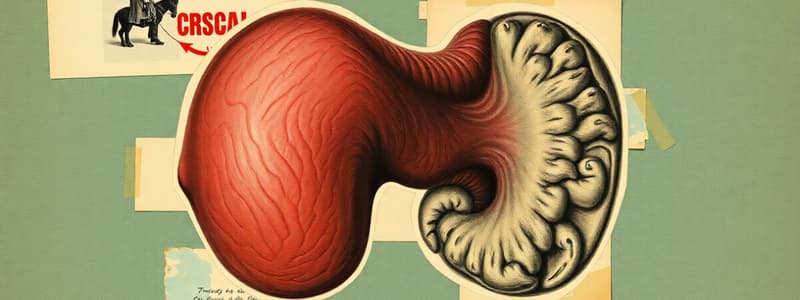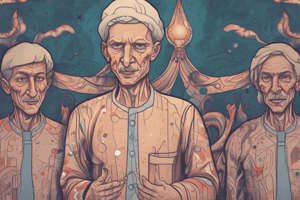Podcast
Questions and Answers
Which factor is most closely associated with the development of benign prostatic hyperplasia (BPH)?
Which factor is most closely associated with the development of benign prostatic hyperplasia (BPH)?
- Bacterial infection of the prostate gland
- Chronic use of diuretics
- History of kidney stones
- Increasing age and hormonal changes (correct)
A patient with BPH is prescribed an alpha-adrenergic antagonist. How does this medication alleviate the patient's symptoms?
A patient with BPH is prescribed an alpha-adrenergic antagonist. How does this medication alleviate the patient's symptoms?
- By preventing the conversion of testosterone to dihydrotestosterone (DHT)
- By decreasing the size of the prostate gland
- By relaxing the smooth muscles of the bladder and prostate (correct)
- By directly increasing urine production
A patient with BPH reports hesitancy, weak stream, and nocturia. Which of the following nursing interventions is most appropriate to recommend?
A patient with BPH reports hesitancy, weak stream, and nocturia. Which of the following nursing interventions is most appropriate to recommend?
- Instruct the patient to limit fluid intake before bedtime.
- Encourage the patient to take diuretics to reduce bladder pressure
- Advise the patient to take aniticholinergics to reduce bladder spasms
- Recommend the patient to avoid alcohol and caffeine (correct)
What is the primary mechanism of action of 5-alpha reductase inhibitors in treating BPH?
What is the primary mechanism of action of 5-alpha reductase inhibitors in treating BPH?
Following a transurethral resection of the prostate (TURP), a patient has continuous bladder irrigation. What should the nurse do if the urine output is dark red with clots?
Following a transurethral resection of the prostate (TURP), a patient has continuous bladder irrigation. What should the nurse do if the urine output is dark red with clots?
A patient with BPH is also being treated for hypertension. Which class of medications used to treat hypertension might also help alleviate his BPH symptoms?
A patient with BPH is also being treated for hypertension. Which class of medications used to treat hypertension might also help alleviate his BPH symptoms?
What is the rationale behind advising patients with BPH to avoid medications with anticholinergic effects?
What is the rationale behind advising patients with BPH to avoid medications with anticholinergic effects?
A patient with BPH is scheduled for a digital rectal exam (DRE). What is the primary purpose of this examination?
A patient with BPH is scheduled for a digital rectal exam (DRE). What is the primary purpose of this examination?
Which of the following complications is associated with benign prostatic hyperplasia (BPH)?
Which of the following complications is associated with benign prostatic hyperplasia (BPH)?
What is a key instruction a nurse should provide to a patient with BPH concerning fluid intake?
What is a key instruction a nurse should provide to a patient with BPH concerning fluid intake?
Flashcards
Benign Prostatic Hyperplasia (BPH)
Benign Prostatic Hyperplasia (BPH)
Gradual enlargement of the prostate gland, compressing the urethra, leading to voiding dysfunction. Common in men over 50.
Risk factors for BPH
Risk factors for BPH
Hypertension, insulin resistance, obesity, and increased dihydrotestosterone levels.
Early symptoms of BPH
Early symptoms of BPH
Weak urinary stream, intermittency, incomplete bladder emptying, hesitancy, and straining to void.
Storage symptoms of BPH
Storage symptoms of BPH
Signup and view all the flashcards
Complications of BPH
Complications of BPH
Signup and view all the flashcards
Diagnostic procedures for BPH
Diagnostic procedures for BPH
Signup and view all the flashcards
Alpha-adrenergic Antagonists for BPH
Alpha-adrenergic Antagonists for BPH
Signup and view all the flashcards
5-alpha Reductase Inhibitors for BPH
5-alpha Reductase Inhibitors for BPH
Signup and view all the flashcards
Transurethral Resection of the Prostate (TURP)
Transurethral Resection of the Prostate (TURP)
Signup and view all the flashcards
Post-TURP Urine Color
Post-TURP Urine Color
Signup and view all the flashcards
Study Notes
- Benign Prostatic Hyperplasia (BPH) affects males over 50, with an unknown cause
- BPH involves the gradual and abnormal enlargement of the prostate gland, compressing the urethra and causing voiding dysfunction
- BPH may be asymptomatic in early stages, often recognized during routine physical exams
Risk Factors
- Risk factors include hypertension, insulin resistance, obesity, and dihydrotestosterone (androgen-specific related to prostate tissue growth)
Clinical Features
- As prostate tissue enlarges, it constricts the urethra, leading to a smaller lumen and space for urine exiting the bladder
Early Symptoms (Obstructive Signs)
- Early symptoms involve voiding problems such as weak urinary stream, intermittency, and incomplete bladder emptying with post-void residual
- Hesitancy causes trouble initiating urine flow and requires abdominal pressure to help push urine out of the bladder
- Straining to void is also a symptom
Storage (Irritative, Filling) Symptoms
- Storage symptoms due to the growing bladder size from overfilling of urine include frequent and urgent urination, nocturia and incontinence
- Incontinence results from spasm and contraction of the bladder muscle, increasing pressure against the urethra
Complications
- Potential complications include hydronephrosis and kidney dysfunction, urinary tract infections like bladder cystitis or kidney pyelonephritis, and hematuria
Diagnostic Procedures
- Diagnostic procedures involve a routine digital rectal examination to check for abnormal prostate enlargement
- Routine urinalysis checks for bacteria and leukocytosis
- Checking serum creatinine and BUN levels assess kidney function
Pharmacotherapy
- Alpha-adrenergic antagonists/alpha-1 receptor blockers offer immediate action as smooth muscle relaxants on the bladder and prostate, without reducing prostate size (e.g., tamsulosin and doxazosin)
- Alpha 1-receptors exist in smooth muscles like the prostate and bladder neck, causing constriction when activated; blocking agents promote relaxation
- Monitor for orthostatic hypotension and implement fall precautions
5-alpha Reductase Inhibitors
- 5-alpha reductase inhibitors (finasteride) offers hormonal manipulation
- These inhibitors convert testosterone to dihydrotestosterone (DHT), limiting DHT to decrease prostate size, relieve bladder obstruction, and allow free urine flow
Complementary and Alternative Therapies
- Complementary and alternative therapies (CATs) example is Saw Palmetto extract but the consulting with a healthcare provider
Nursing Interventions
- Nursing interventions include urinalysis and assessing bladder distention and high postvoid residual, which can be done via palpating the abdomen or using a bladder scan after the client has urinated, ensuring privacy for the client
Teach Client
- Reduce intake of mild diuretics (caffeine, alcohol) and highly seasoned food to avoid bladder irritation
- Urinate frequently (every 2-3 hours) due to a high risk of urinary stasis
- Avoid constipation to prevent pressure on the bladder and prostate
Additional Teaching
- Avoid medications causing urinary retention, such as anticholinergics, antihistamines, and decongestants, as they reduce bladder muscle contractions
- Bladder muscle neck contraction is needed to push against obstruction
Severe Cases
- For severe cases, a transurethral resection, which is a surgical procedure removing part of the prostate, maybe required
- Provide and monitor continuous bladder irrigation post-resection
- Normal urine output should be light pink, while dark or red output may require increased irrigation flow rate or a prescription from a healthcare provider to irrigate the bladder in the presence of a clot
Monitoring Clot Presence
- Monitoring for the presence of clots is necessary
- Bladder spasms and decreased output may indicate clot presence, and sterile water irrigation is necessary to dislodge clots, as prescribed
Studying That Suits You
Use AI to generate personalized quizzes and flashcards to suit your learning preferences.



